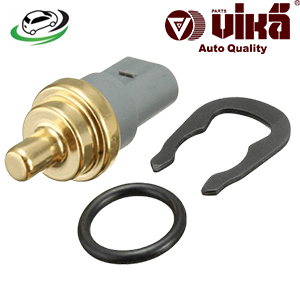-28%
Get Coolant Temperature Sensor Audi 4M Q7/Audi 8U Q3 2.0T/Audi 8Y RS 3/Audi A3 8P/Audi A3 8V / VW Beetle/Golf V/V1/R/Tiguan/Touareg 06A919501A
The coolant temperature sensor (CTS) is a crucial component in modern internal combustion engines, designed to monitor the temperature of the engine’s coolant. This data is vital for the engine control unit (ECU) to optimize engine performance, efficiency, and emissions. Here’s an in-depth look at the coolant temperature sensor:
Function and Importance
- Monitoring Engine Temperature: The primary function of the coolant temperature sensor is to measure the temperature of the engine coolant, which directly correlates with the engine’s operating temperature. This helps in preventing overheating, which can cause severe engine damage.
- Engine Performance: The ECU relies on accurate temperature data to adjust fuel injection timing, ignition timing, and air-fuel mixture. Optimal engine performance and fuel efficiency are achieved by ensuring the engine operates within its ideal temperature range.
- Emission Control: The sensor helps in maintaining the correct operating temperature, which is crucial for the proper functioning of the catalytic converter and other emission control systems. This helps in reducing harmful exhaust emissions.
- Auxiliary Systems: The data from the coolant temperature sensor is also used to control auxiliary systems like the radiator fans and the operation of the air conditioning system.
How It Works
The coolant temperature sensor is typically a thermistor, which is a type of resistor whose resistance varies with temperature. There are two main types of thermistors used in coolant temperature sensors:
- Negative Temperature Coefficient (NTC) Thermistors: In these sensors, resistance decreases as the temperature increases. They are the most common type used in automotive applications.
- Positive Temperature Coefficient (PTC) Thermistors: In these sensors, resistance increases as the temperature rises. They are less common in automotive applications.
The sensor is usually located near the thermostat or directly in the engine block, where it can accurately measure the temperature of the coolant as it circulates through the engine. It is connected to the ECU, and as the coolant temperature changes, the resistance of the sensor changes. The ECU interprets this change in resistance as a temperature reading.
Typical Operation
When the engine is cold, the coolant temperature sensor sends a signal to the ECU indicating a low temperature. The ECU responds by adjusting the fuel mixture to be richer (more fuel) to help the engine warm up quickly. As the engine reaches its optimal operating temperature, the sensor signals this to the ECU, which then adjusts the fuel mixture to be leaner (less fuel) for efficient combustion.
Common Issues and Symptoms
A faulty coolant temperature sensor can lead to a variety of engine performance issues. Common symptoms include:
- Poor Fuel Economy: If the sensor sends incorrect temperature readings, the ECU may enrich the fuel mixture unnecessarily, leading to increased fuel consumption.
- Engine Overheating: A malfunctioning sensor might not trigger the cooling fans, causing the engine to overheat.
- Hard Starting: Incorrect temperature readings can affect the fuel mixture, making the engine difficult to start, especially in cold conditions.
- Check Engine Light: A faulty sensor can trigger the check engine light, indicating an issue with the engine management system.
- Erratic Temperature Gauge Readings: If the sensor is failing, the temperature gauge on the dashboard may show erratic readings or fail to move at all.
Benefits of Coolant Temperature Sensor
1. Optimal Engine Performance
The CTS helps the engine control unit (ECU) maintain the ideal operating temperature, ensuring that the engine runs efficiently. By providing real-time temperature data, the ECU can adjust fuel injection timing, ignition timing, and air-fuel mixture, resulting in optimal engine performance.
2. Enhanced Fuel Efficiency
Accurate temperature readings allow the ECU to adjust the fuel mixture according to the engine’s needs. When the engine is cold, a richer fuel mixture is necessary, but as it warms up, a leaner mixture is more efficient. This precise control helps to maximize fuel economy.
3. Reduced Emissions
A properly functioning CTS ensures that the engine operates within its optimal temperature range, which is crucial for the effective operation of the catalytic converter and other emission control systems. This leads to a reduction in harmful exhaust emissions, contributing to a cleaner environment.
4. Prevention of Engine Overheating
The CTS plays a vital role in monitoring the engine’s temperature and triggering the cooling fans when necessary. By doing so, it helps prevent the engine from overheating, which can cause severe damage and lead to costly repairs.
5. Improved Cold Starting
In cold conditions, the CTS ensures that the ECU enriches the fuel mixture, making it easier to start the engine. This prevents hard starting issues and ensures that the engine warms up quickly and efficiently.
6. Enhanced Engine Longevity
By maintaining the correct operating temperature, the CTS helps reduce engine wear and tear. Operating the engine within its optimal temperature range prevents overheating and thermal stress, which can prolong the engine’s lifespan.
7. Accurate Temperature Gauge Readings
The CTS provides the data needed for the temperature gauge on the dashboard. Accurate readings allow the driver to monitor the engine’s temperature and take necessary actions if the temperature rises unexpectedly, preventing potential engine damage.
8. Controlled Auxiliary Systems
The CTS data is used to control various auxiliary systems such as the radiator fans and air conditioning system. For example, the air conditioning system may be turned off temporarily when the engine is too hot to reduce the load and prevent overheating.
9. Improved Driveability
A properly functioning CTS ensures smooth engine operation by maintaining the correct temperature. This results in improved driveability, with fewer engine performance issues such as stalling, rough idling, or hesitation during acceleration.
10. Cost Savings
By preventing engine overheating and optimizing fuel efficiency, the CTS can save money on fuel and avoid costly repairs related to engine damage. Additionally, maintaining proper emissions levels can prevent fines or penalties in regions with strict emissions regulations.
Signs of a faulty Coolant Temperature Sensor
1. Poor Fuel Economy
A failing CTS can send incorrect temperature readings to the ECU, causing the engine to run with an improper air-fuel mixture. This often results in the engine running richer (more fuel) than necessary, leading to increased fuel consumption and reduced fuel efficiency.
2. Engine Overheating
If the CTS is not providing accurate temperature readings, the ECU may not activate the cooling fans at the right time. This can cause the engine to overheat, potentially leading to severe engine damage.
3. Hard Starting
Incorrect temperature data can affect the fuel mixture, making the engine difficult to start, especially in cold conditions. A faulty CTS might cause the engine to receive too much or too little fuel during startup.
4. Check Engine Light
A malfunctioning CTS often triggers the check engine light on the dashboard. The ECU detects the irregularities in the sensor’s readings and logs a fault code, which can be diagnosed using an OBD-II scanner.
5. Black Smoke from Exhaust
If the CTS fails and causes the engine to run rich, you might notice black smoke coming from the exhaust. This indicates incomplete combustion due to excessive fuel in the mixture.
6. Poor Engine Performance
A faulty CTS can lead to poor engine performance, including rough idling, hesitation, or stumbling during acceleration. These symptoms occur because the ECU cannot properly adjust the engine parameters without accurate temperature information.
7. Erratic Temperature Gauge Readings
If the CTS is sending erratic or inaccurate signals, the temperature gauge on the dashboard may show inconsistent readings. It might fluctuate wildly, show a constant low or high temperature, or fail to move at all.
8. Increased Emissions
Incorrect temperature readings can lead to improper air-fuel mixture adjustments, resulting in higher emissions. This can cause the vehicle to fail emissions tests and contribute to environmental pollution.
Follow us on Facebook for more parts.



